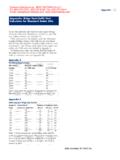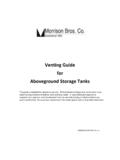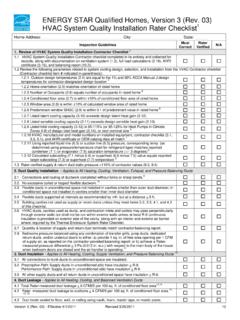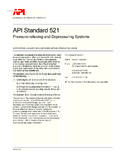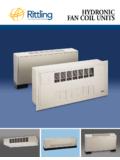Transcription of METHOD 6C DETERMINATION OF SULFUR DIOXIDE …
1 METHOD 6C 8/2/2017 1 While we have taken steps to ensure the accuracy of this Internet version of the document, it is not the official version. The most recent edits to this METHOD were published here: To see a complete version including any recent edits, visit: and search under Title 40, Protection of Environment. METHOD 6C DETERMINATION OF SULFUR DIOXIDE EMISSIONS FROM STATIONARY SOURCES (INSTRUMENTAL ANALYZER PROCEDURE) Scope and Application What is METHOD 6C? METHOD 6C is a procedure for measuring SULFUR DIOXIDE (SO2) in stationary source emissions using a continuous instrumental analyzer. Quality assurance and quality control requirements are included to assure that you, the tester, collect data of known quality.
2 You must document your adherence to these specific requirements for equipment, supplies, sample collection and analysis, calculations, and data analysis. This METHOD does not completely describe all equipment, supplies, and sampling and analytical procedures you will need but refers to other methods for some of the details. Therefore, to obtain reliable results, you should also have a thorough knowledge of these additional test methods which are found in appendix A to this part: (a) METHOD 1 Sample and Velocity Traverses for Stationary Sources. (b) METHOD 4 DETERMINATION of Moisture Content in Stack Gases. (c) METHOD 6 DETERMINATION of SULFUR DIOXIDE Emissions from Stationary Sources. (d) METHOD 7E DETERMINATION of Nitrogen Oxides Emissions from Stationary Sources (Instrumental Analyzer Procedure).
3 Analytes. What does this METHOD determine? This METHOD measures the concentration of SULFUR DIOXIDE . Analyte CAS No. Sensitivity SO2 7446-09-5 Typically <2% of Calibration Span. Applicability. When is this METHOD required? The use of METHOD 6C may be required by specific New Source Performance Standards, Clean Air Marketing rules, State Implementation Plans, and permits where SO2 concentrations in stationary source emissions must be measured, either to determine compliance with an applicable emission standard or to conduct performance testing of a continuous emission monitoring system (CEMS). Other regulations may also require the use of METHOD 6C. METHOD 6C 8/2/2017 2 Data Quality Objectives. How good must my collected data be?
4 Refer to section of METHOD 7E. Summary of METHOD In this METHOD , you continuously sample the effluent gas and convey the sample to an analyzer that measures the concentration of SO2. You must meet the performance requirements of this METHOD to validate your data. Definitions Refer to section of METHOD 7E for the applicable definitions. Interferences Refer to Section of METHOD 7E. Safety Refer to section of METHOD 7E. Equipment and Supplies Figure 7E-1 of METHOD 7E is a schematic diagram of an acceptable measurement system. What do I need for the measurement system? The essential components of the measurement system are the same as those in sections and of METHOD 7E, except that the SO2 analyzer described in section of this METHOD must be used instead of the analyzer described in section of METHOD 7E.
5 You must follow the noted specifications in section of METHOD 7E. What analyzer must I use? You may use an instrument that uses an ultraviolet, non-dispersive infrared, fluorescence, or other detection principle to continuously measure SO2 in the gas stream and meets the performance specifications in section The low-range and dual-range analyzer provisions in sections and of METHOD 7E apply. Reagents and Standards Calibration Gas. What calibration gases do I need? Refer to section of METHOD 7E for the calibration gas requirements. Example calibration gas mixtures are listed below. (a) SO2 in nitrogen (N2). (b) SO2 in air. (c) SO2 and CO2 in N2. METHOD 6C 8/2/2017 3 (d) SO2 andO2 in N2. (e) SO2/CO2/O2 gas mixture in N2.
6 (f) CO2/NOX gas mixture in N2. (g) CO2/SO2/NOX gas mixture in N2. Interference Check. What additional reagents do I need for the interference check? The test gases for the interference check are listed in Table 7E-3 of METHOD 7E. For the alternative interference check, you must use the reagents described in section of METHOD 6. Sample Collection, Preservation, Storage, and Transport Sampling Site and Sampling Points. You must follow the procedures of section of METHOD 7E. Initial Measurement System Performance Tests. You must follow the procedures in section of METHOD 7E. If a dilution-type measurement system is used, the special considerations in section of METHOD 7E also apply. Interference Check.
7 You must follow the procedures of section of METHOD 7E to conduct an interference check, substituting SO2 for NOX as the METHOD pollutant. For dilution-type measurement systems, you must use the alternative interference check procedure in section 16 and a co-located, unmodified METHOD 6 sampling train. Sample Collection. You must follow the procedures of section of METHOD 7E. Post-Run System Bias Check and Drift Assessment. You must follow the procedures of section of METHOD 7E. Quality Control Follow quality control procedures in section of METHOD 7E. Calibration and Standardization Follow the procedures for calibration and standardization in section of METHOD 7E. Analytical Procedures Because sample collection and analysis are performed together (see section 8), additional discussion of the analytical procedure is not necessary.
8 Calculations and Data Analysis METHOD 6C 8/2/2017 4 You must follow the applicable procedures for calculations and data analysis in section of METHOD 7E as applicable, substituting SO2 for NOX as appropriate. METHOD Performance The specifications for the applicable performance checks are the same as in section of METHOD 7E. Alternative Interference Check. The results are acceptable if the difference between the METHOD 6C result and the modified METHOD 6 result is less than percent of the METHOD 6 result for each of the three test runs. For the purposes of comparison, the METHOD 6 and 6C results must be expressed in the same units of measure. Pollution Prevention [Reserved] Waste Management [Reserved] Alternative Procedures Alternative Interference Check.
9 You may perform an alternative interference check consisting of at least three comparison runs between METHOD 6C and METHOD 6. This check validates the METHOD 6C results at each particular source category (type of facility) where the check is performed. When testing under conditions of low concentrations (<15 ppm), this alternative interference check is not allowed. NOTE: The procedure described below applies to non-dilution sampling systems only. If this alternative interference check is used for a dilution sampling system, use a standard METHOD 6 sampling train and extract the sample directly from the exhaust stream at points collocated with the METHOD 6C sample probe. a. Build the modified METHOD 6 sampling train (flow control valve, two midget impingers containing 3 percent hydrogen peroxide, and dry gas meter) shown in Figure 6C-1.
10 Connect the sampling train to the sample bypass discharge vent. Record the dry gas meter reading before you begin sampling. Simultaneously collect modified METHOD 6 and METHOD 6C samples. Open the flow control valve in the modified METHOD 6 train as you begin to sample with METHOD 6C. Adjust the METHOD 6 sampling rate to 1 liter per minute (.10 percent). The sampling time per run must be the same as for METHOD 6 plus twice the average measurement system response time. If your modified METHOD 6 train does not include a pump, you risk biasing the results high if you over-pressurize the midget impingers and cause a leak. You can reduce this risk by cautiously increasing the flow rate as sampling begins. b. After completing a run, record the final dry gas meter reading, meter temperature, and barometric pressure.










